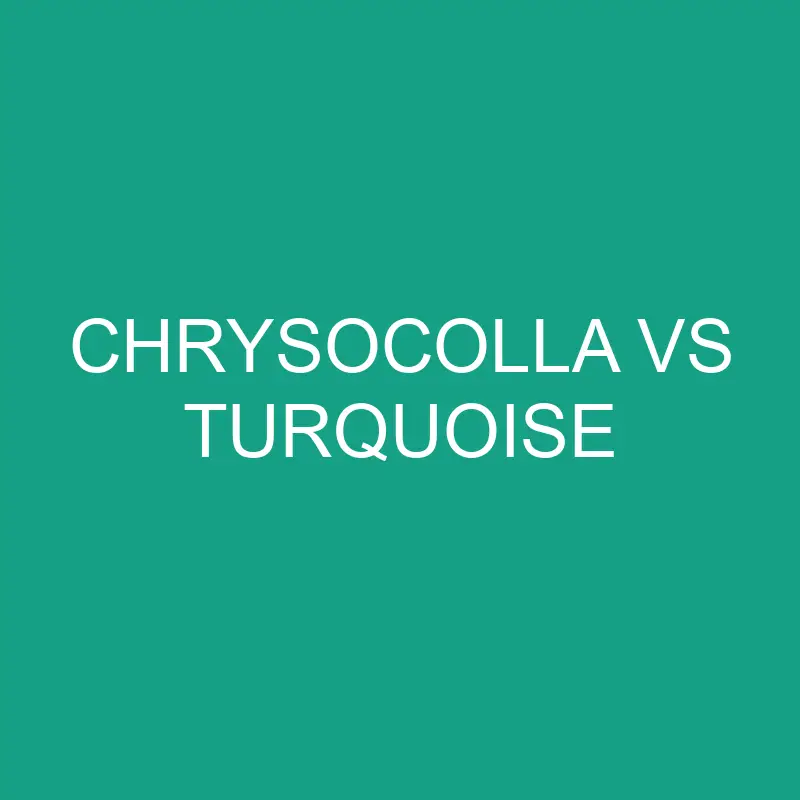Gemstones have fascinated humans for centuries, not only for their exquisite beauty but also for the unique qualities and energies they possess. Chrysocolla and Turquoise, two gemstones often admired for their captivating blue and green hues, are distinct in their compositions, geological origins, and cultural significance. In this comparative exploration, we delve into the characteristics, origins, uses, and metaphysical properties of Chrysocolla and Turquoise.
Post Contents
Chrysocolla: The Serene Green-Blue Gemstone
Origins and Composition:
- Chrysocolla Composition: Chrysocolla is a copper mineral, often found in association with other copper minerals such as malachite and azurite. Its color can range from light green to deep blue, sometimes exhibiting brown or black streaks.
Physical Properties:
- Color and Appearance: Chrysocolla’s color is predominantly green or blue, and its appearance is often characterized by a swirling pattern or mixed with other minerals.
- Transparency: It is generally opaque.
- Luster: Chrysocolla has a vitreous to dull luster.
- Mohs Scale: Its hardness ranges from 2 to 4.
Origins and Mining:
- Locations: Chrysocolla is found in various locations globally, including the United States, Peru, Chile, Israel, and the Democratic Republic of the Congo.
- Mining: It is typically mined as a secondary mineral in copper deposits.
Cultural Significance:
- Historical Use: Chrysocolla has been used historically for jewelry and ornamental purposes. It has also been associated with feminine energy and is believed to have calming properties.
Turquoise: The Revered Sky-Blue Gemstone
Origins and Composition:
- Turquoise Composition: Turquoise is a phosphate mineral that contains copper and aluminum. Its color varies from sky blue to greenish-blue, often displaying brown or black veins known as matrix.
Physical Properties:
- Color and Appearance: Turquoise is renowned for its sky-blue color, and its appearance may include the characteristic matrix patterns.
- Transparency: It is generally opaque.
- Luster: Turquoise has a waxy to subvitreous luster.
- Mohs Scale: Turquoise has a hardness ranging from 5 to 6.
Origins and Mining:
- Locations: Turquoise is found in various locations worldwide, including the United States (Southwest), Iran, China, Mexico, and Egypt.
- Mining: Turquoise is often mined from both primary deposits (where it forms) and secondary deposits (where it has been transported and redeposited).
Cultural Significance:
- Historical Use: Turquoise holds immense cultural significance in various civilizations, including Native American cultures, Ancient Egypt, and Persia. It has been used in jewelry, amulets, and ceremonial objects.
- Symbolism: Turquoise is often associated with protection, wisdom, and positive energy in many cultures.
Comparative Analysis: Chrysocolla vs. Turquoise
Color and Appearance:
- Chrysocolla: Predominantly green or blue with swirling patterns. Can include brown or black streaks.
- Turquoise: Renowned for its sky-blue color, often with brown or black matrix.
Transparency:
- Chrysocolla: Generally opaque.
- Turquoise: Opaque.
Luster:
- Chrysocolla: Vitreous to dull.
- Turquoise: Waxy to subvitreous.
Hardness (Mohs Scale):
- Chrysocolla: 2 to 4.
- Turquoise: 5 to 6.
Mining:
- Chrysocolla: Typically mined as a secondary mineral in copper deposits.
- Turquoise: Mined from both primary and secondary deposits.
Cultural Significance:
- Chrysocolla: Historical use in jewelry and ornaments, associated with feminine energy and calming properties.
- Turquoise: Revered in various cultures, especially among Native Americans, associated with protection, wisdom, and positive energy.
Metaphysical Properties: Chrysocolla vs. Turquoise
Chrysocolla:
- Communication: Associated with clear communication and expression.
- Calming Energy: Believed to have calming properties, promoting tranquility and inner balance.
Turquoise:
- Protection: Often used as a protective amulet.
- Spiritual Connection: Associated with spiritual wisdom and positive energy.
Uses in Jewelry and Art:
Chrysocolla:
- Chrysocolla is used in jewelry, often as cabochons or beads. Its swirling patterns make each piece unique.
- Artistic Use: Chrysocolla is favored for its artistic appeal in sculptures and decorative objects.
Turquoise:
- Turquoise is highly sought after in jewelry, from rings and necklaces to earrings and bracelets.
- Artistic Use: Turquoise is often used in Native American jewelry and inlays in various art forms.
Conclusion: Chrysocolla vs. Turquoise
In the world of gemstones, Chrysocolla and Turquoise, both exhibiting captivating blue and green hues, offer distinct qualities. Chrysocolla is appreciated for its calming energy and unique patterns, often seen in artistic creations. Turquoise, with its revered cultural significance, is cherished for its sky-blue color and positive energy, making it a sought-after gemstone in jewelry and spiritual practices.
The choice between Chrysocolla and Turquoise often comes down to personal preferences, whether one is drawn to the swirling patterns of Chrysocolla or the rich cultural history and symbolic meanings associated with Turquoise. Both gemstones contribute to the rich diversity of the mineral kingdom, offering beauty, symbolism, and metaphysical energy to those who choose to incorporate them into their lives.
